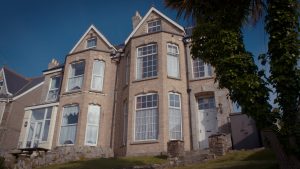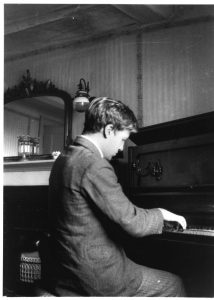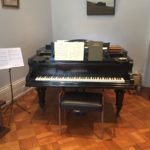We are offering support for students and teachers. Please click here.
William Golding was born on 19th September, 1911, at his grandparents’ house in Newquay, Cornwall. The house, called Karenza – Cornish for ‘love’ – was aptly named since Newquay, and Cornwall more generally, became one of Golding’s most cherished places. He wrote that ‘my early memories of my birthplace have a certain glamour about them’ (‘Scenes from a Life’), and Golding loved the golden beaches of North Cornwall. He would swim in the sea no matter the weather and his boyish joy is mirrored later in Lord of the Flies. Shortly after crashing on the island, before the descent into savagery, Ralph is thrilled at their new-found freedom. He stands on his head in delight and exclaims ‘Whizzoh’ as he dives into the sea.

However, there was something darker on the beaches of Cornwall, which anticipates the darker turn in Golding’s first novel. During the First World War, German U-boats attacked British supply ships, and as Carey writes, ‘the windows at Karenza gave him his first look at warfare’. Golding’s older brother José and other boys would go to the beach and watch the survivors being brought to shore in lifeboats. Golding wasn’t allowed due to his age but he recalled that José told him that ‘there were “bits of men” in the boats’. In another memory from the Karenza windows, he remembers seeing a ‘thin trail of smoke’ coming closer to the bay; an image remarkably close to the ‘tight little knot of smoke’ Ralph sees on the horizon, signalling a potential rescue ship.
Aside from the family holidays to Newquay, Golding grew up in Marlborough, Wiltshire. His father, Alec, was born in Bristol in 1876, and became a teacher. Through a teaching post in Newquay, he met Golding’s mother, Mildred, and they married in Truro Cathedral in 1906. Alec gained a teaching post at Marlborough Grammar School in 1905, so after the marriage, they moved to Marlborough. José was born in 1906.

The Goldings moved into 29 The Green in the centre of Marlborough, a house that backed onto St Mary’s Church graveyard, and as a small boy, Golding became terrified of the graves. He saw headstones resting against their garden wall and deduced that the bodies must be in his garden. This fear meant he would avoid the garden lawn, and climbed a chestnut tree in the garden to try not to step on it. The house’s cellar haunted his nightmares for the rest of his life and he called it a place of ‘numinous dread’. He would write about these dreams in Pincher Martin:
‘I’d think of anything because if I didn’t go on thinking I’d remember whatever was in the cellar down there, and my mind would go walking away from my body and go down three stories defenceless, down the dark stairs past the tall, haunted clock, through the whining door, down the terrible steps to where the coffin ends were crushed in the walls of the cellar.’
This preoccupation with death extended into Golding’s interest in Ancient Egypt, particularly mummification and the mysteries of the Pharoahs. He would often visit Bristol Museum with his paternal grandparents, and was fascinated by their Egyptian artefacts and displays. He had a vivid daydream that the curator asked him to help while he unravelled the bindings from a mummy, and he remembered this throughout his life. Golding learned hieroglyphics in order to write a play set in this ancient civilisation and his interest continued into adulthood. His 1969 novella The Scorpion God centres around Ancient Egyptian rituals of death and the afterlife.
Golding retained other vivid memories of his dreams from childhood from the Marlborough house, which were not as frightening as those from the cellar. He recalled seeing a ‘cockerel’-like creature crawling on a curtain pole, which radiated absolute ‘friendliness’. It was a great sadness to him that the creature never came back. Another happy memory was from the family’s weekly visit to Savernake Forest in Wiltshire; he described it as a ‘settled part’ of himself. He was particularly struck by the landscape of the forest: ‘The fronds make a nearly light-proof cover so that looking sideways you look into a deep gloom interrupted only by the vertical stems and thunderous with the business of uncountable flies’ (‘Scenes from a Life’). Savernake Forest was the inspiration for the setting of The Inheritors, with dense forests and rushing rivers.
In his short memoir, ‘Billy The Kid’, Golding relates his early school days. He was inexperienced in social situations and ended up fighting with the other children, then wondered why they didn’t like him. His mother had a ‘long talk’ with his teacher and things were mostly resolved. In 1919, at the age of 8, he received a prize of a book with an inscription: ‘Billy Golding 1919 Prize for General Improvement’. He held the book open on the inscription for the whole six-hour train journey to Newquay.
Golding commenced his secondary education in 1921, attending Marlborough Grammar School, where his father taught. Alec Golding was an immensely popular and creative teacher, and he was the basis for Nick Shales, a character in Free Fall (1959). In the novel, narrator, Sammy Mountjoy tells us that ‘Nick was the best teacher I ever knew. He had no particular method and he gave no particular picture of brilliance; it was just that he had a vision of nature and a passionate desire to communicate it’. Golding did well at school academically, and also in sports, competing at county level in sprinting, and was appointed captain of the cricket team in sixth form.

However, the move to secondary education prompted another of Golding’s lifelong preoccupations. Marlborough was also home to Marlborough College, one of the top public schools in the country. He was jealous of the privileged boys who attended the College, and became aware of the sharp distinctions in social class which pervaded society. Golding explored social class in his realist novel The Pyramid (1967); the title, as Golding explains, comes from the ‘English Social pyramid, a particularly crippling and terrible structure’. There are other resonances of Golding’s childhood in The Pyramid. The protagonist Oliver is a talented musician and has lessons with an eccentric spinster, known as Bounce. Bounce is based on Golding’s own music teacher Miss Salisbury, and like Oliver, Golding was initially keen to focus on music at undergraduate level. Oliver is unable to pursue music as, in the novel, it is not considered to be a worthwhile profession.
Golding’s feelings of social inadequacy continued when he went up to Brasenose College, Oxford. His fellow undergraduates were mostly young men from public schools and as he wasn’t awarded a scholarship, his parents had to pay for everything. Oxford was an unhappy experience for Golding, particularly as he disliked his chosen subject of Natural Sciences. He eventually changed to English Literature, which extended his time at Oxford by a year, but he graduated with an excellent second. A final reminder of his social status came from a comment on his record at the end of his studies: ‘NTS’, meaning ‘Not Top Shelf’ and therefore, unfit to teach at public schools. Despite his experience, he returned to Brasenose in 1937 for his Diploma in Education.
In 1934, at the age of 23, Golding’s first published work appeared – Poems, published by Macmillan as part of their Contemporary Poets series. The book featured thirty poems but Golding was disappointed that the literary establishment gave little attention to them. This led to a period of uncertainty about the future; he moved to London and tried acting, before eventually gaining his first teaching post in 1935. In 1938, he was appointed as a teacher at Maidstone Grammar School in Kent, where his romantic life was about to take an unexpected turn.
Golding had been engaged to a woman from Marlborough, Mollie Evans, sometime in the 1930s. Mollie was well-liked by his parents, especially Alec, who had taught her. However, in 1938, Golding met Ann Brookfield, an event that he later fictionalised in Free Fall:
‘She was dark and vivid. She had the kind of face that always looks made-up, even in the bath – such black eyebrows, such a big, red mouth. She was the prettiest girl I ever saw, neat in profile, with soft cheeks and two dimples that were in stunning contrast with her tenor voice and scarifying language.’
In Golding’s own words, he ‘ditched the girl I was going to marry and married Ann instead’, and he felt shame about his treatment of Mollie throughout his life. He would occasionally dream about her and she, too, provided the basis for a character in Free Fall, Beatrice Ifor. John Carey also suggests that the character of Mary in Pincher Martin is inspired by Mollie, although if this is the case Mollie has her revenge as Mary rejects the attentions of Christopher Martin. Golding and Ann married in 1939, and then Golding lost his job at Maidstone Grammar, due to, as he puts it, ‘an unacademic combination of drink, women and politics’. His next position was at Bishop Wordsworth’s School in Salisbury, where he had undertaken his teaching practice. Their son, David, was born in 1940. Shortly afterwards, Golding enlisted in the Navy to fight in the Second World War, where he would endure the worst horrors of his lifetime.

Further reading:
John Carey, William Golding: The Man Who Wrote Lord of the Flies. (Faber and Faber, 2009).
Judy Carver (Golding), ‘William Golding’s Mother’. (In Writers and their Mothers, edited by Dale Salwak, Palgrave, 2018).
Judy Golding, The Children of Lovers. (Faber and Faber, 2011).
William Golding, ‘Scenes From A Life’. (Arete, Summer 2000).
William Golding, The Hot Gates. (Faber and Faber, 2013, new ed.)
More images of William Golding’s early life at Pinterest

